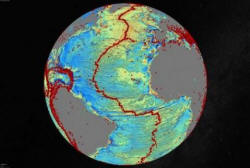|
 Global
seafloor map reveals stunning details of Earth's depths Global
seafloor map reveals stunning details of Earth's depths
 Send a link to a friend
Send a link to a friend
[October 03, 2014]
By Will Dunham
WASHINGTON (Reuters) - Scientists have devised a new map of the Earth's
seafloor using satellite data, revealing massive underwater scars and
thousands of previously uncharted sea mountains residing in some of the
deepest, most remote reaches of the world's oceans.
|
|
 The researchers said on Thursday they used gravity measurements of
the seafloor from radar equipment aboard the European Space Agency's
CryoSat-2 satellite and NASA's Jason-1 satellite to capture
underwater geological features in unprecedented detail. The researchers said on Thursday they used gravity measurements of
the seafloor from radar equipment aboard the European Space Agency's
CryoSat-2 satellite and NASA's Jason-1 satellite to capture
underwater geological features in unprecedented detail.
"The pull of gravity reflects the topography and tectonics of the
seafloor," said David Sandwell, a geophysicist at Scripps
Institution of Oceanography at the University of California, San
Diego who led the study.
University of Sydney geophysicist Dietmar Müller, another of the
researchers, said about 71 percent of the Earth's surface is covered
by water and roughly 90 percent of the seafloor is uncharted by
survey ships that employ acoustic beams to map the depths.
"We know much more about the topography of Mars than we know about
Earth's seafloor," Müller said. "The disappearance of Malaysia
Airlines flight MH370 earlier this year has heightened global
awareness of the poor knowledge of our ocean depths."

The map reveals major seafloor and sub-seafloor structures. They
include a mid-ocean ridge beneath the Gulf of Mexico with a length
about equal to the width of Texas as well as another ridge under the
South Atlantic west of Angola about 500 miles (800 km) long that was
formed just after the continent of South America separated from
Africa.
Such "spreading ridges" are cracks in the Earth formed where the
planet's tectonic plates moved apart and molten material called
magma came up to fill them, the researchers said.
"Knowing where and when such ridges existed is essential for
deciphering planet Earth's geological past," Müller said.
The new map also provides details on thousands of undersea
mountains, or seamounts, rising 1 mile (1.6 km) or more from the
seafloor, the researchers said. Some are covered by many miles (km)
of sediments, they said.
[to top of second column] |

In addition to the pure scientific value, the new map could have
applications for militaries and for oil exploration, Sandwell said.
Müller said the conclusions the researchers made about seabed
topography may be less accurate than acoustic beam methods employed
by ships.
"But the global coverage is much better and our method is much
cheaper, especially as we are mostly using satellite data that were
collected for another purpose," added Müller, who estimated that a
complete survey of the deep ocean using ships would cost between $2
billion and $3 billion and would take many years.
CryoSat-2 was dedicated to monitoring changes in the thickness of
marine ice floating in the polar oceans and variations in the
thickness of the vast ice sheets that overlie Greenland and
Antarctica. Jason-1 was dedicated to map the change in the
topography of the oceans due to ocean currents.
The study was published in the journal Science.
(Reporting by Will Dunham; Editing by Cynthia Osterman)
[© 2014 Thomson Reuters. All rights
reserved.] Copyright 2014 Reuters. All rights reserved. This material may not be published,
broadcast, rewritten or redistributed.
 |